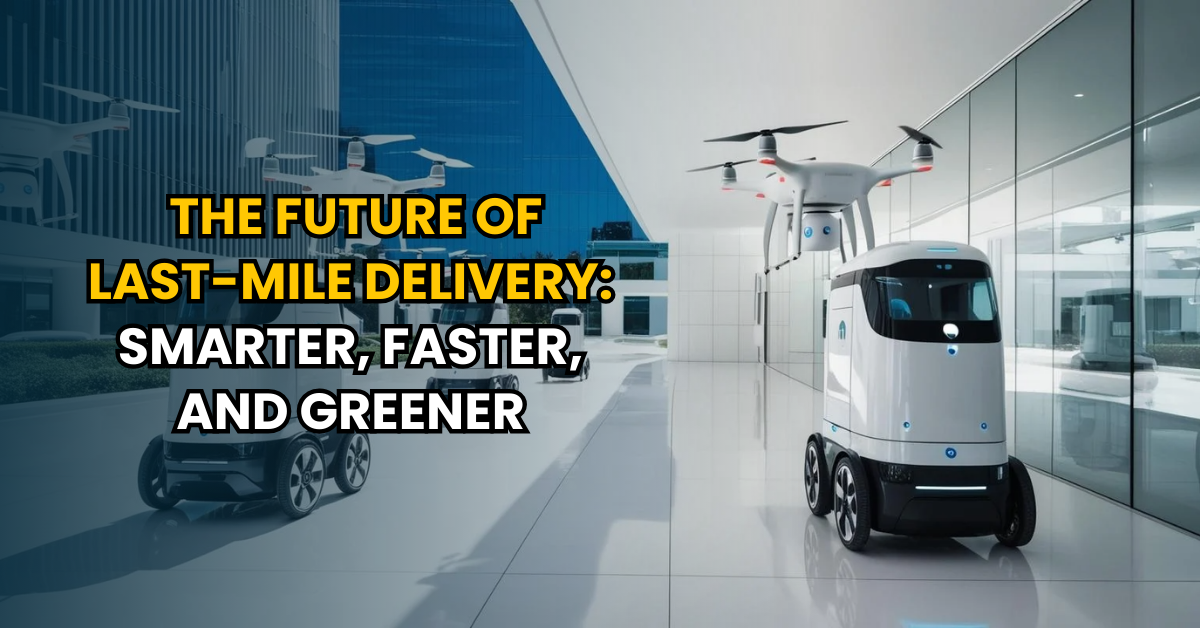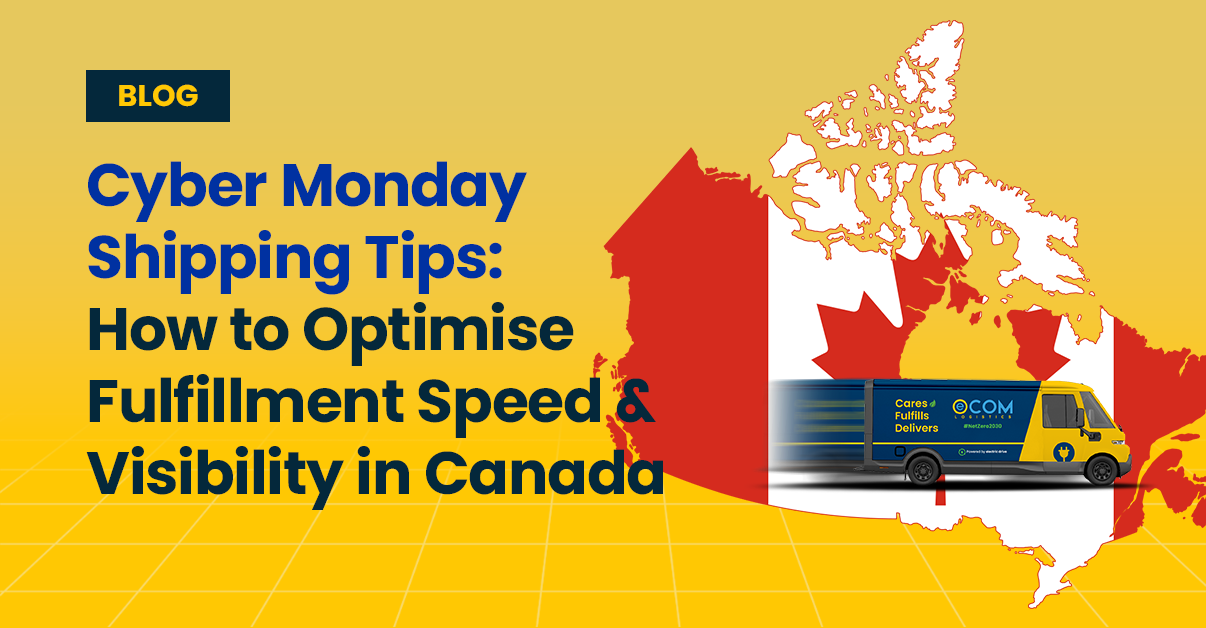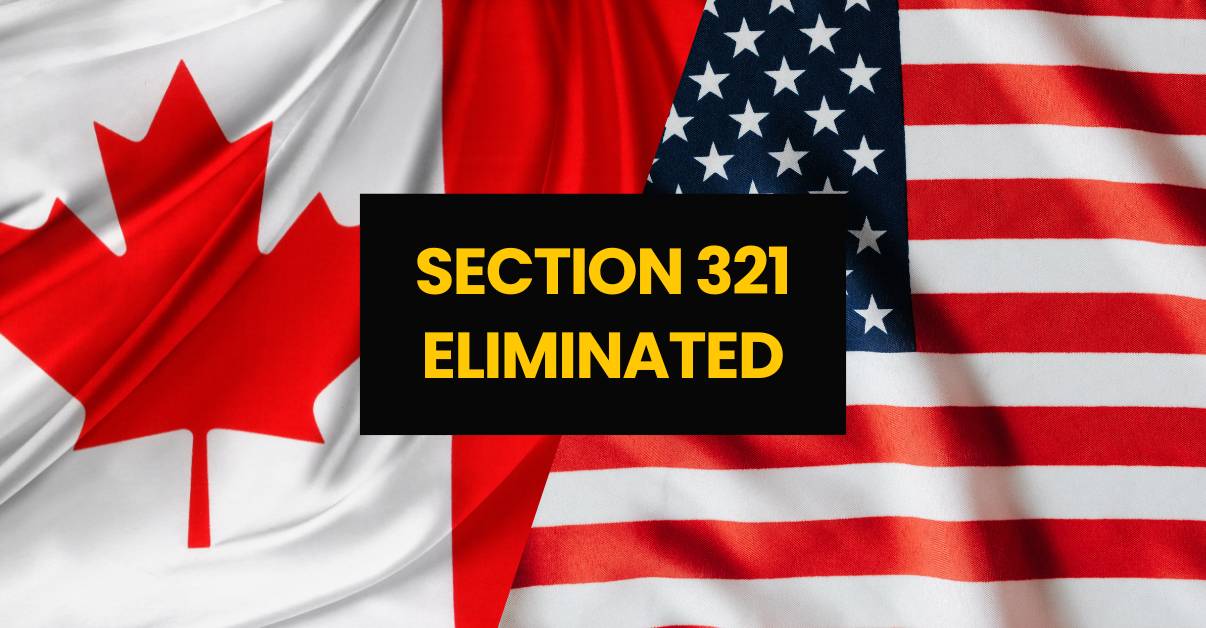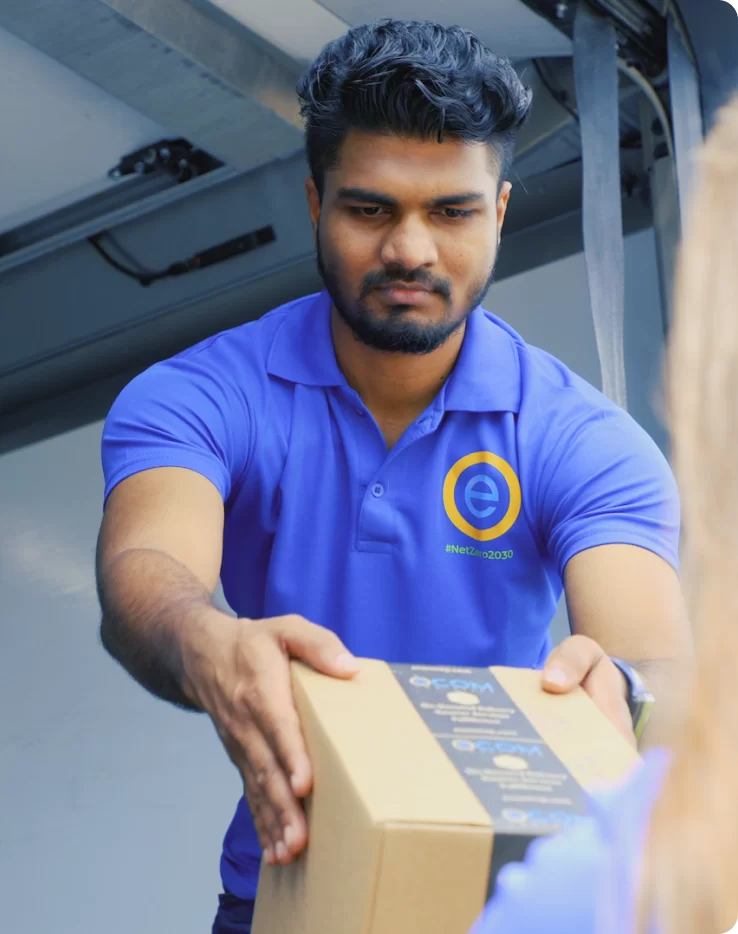Fast delivery isn’t just a perk anymore, it’s what makes or breaks a sale. Customers expect their orders to arrive quickly, with real-time tracking and flexible delivery options. And if they don’t get that? They’ll shop elsewhere. In fact, 85% of online shoppers say a bad delivery experience would stop them from ordering again.
With 29 million Canadians shopping online in 2024—and that number only growing—expectations are higher than ever. Same-day, next-day, and even three-hour deliveries are quickly becoming the norm. At the same time, sustainability is no longer optional; businesses are under pressure to reduce their carbon footprint while keeping up with demand.
So, how is last-mile delivery evolving to meet these challenges? From AI-driven route optimization to electric cargo bikes and other green solutions, logistics is transforming faster than ever. In this blog, we’ll break down the key trends shaping last-mile delivery in 2025—and what e-commerce businesses need to do to stay ahead.
Emerging technologies transforming last-mile delivery
Online shopping was already big, but the pandemic sent it into overdrive. Now, people expect everything from groceries to furniture to show up at their door in days—or even hours.
To put the growth in perspective, the global last-mile delivery market was worth $146.8 billion in 2023 and is projected to more than double to $340.56 billion by 2032, with a 9.8% annual growth rate. That’s a lot of packages moving through an already strained system.
Traditional delivery methods just aren’t cutting it anymore—consumer expectations keep rising, and businesses are struggling to keep up. So, what’s the secret to keeping customers happy? That question has sparked a whole new era of last-mile delivery. Let’s take a look at the emerging trends transforming the final leg of the supply chain.
1. Drones:
Imagine placing an order online and having a drone drop it off at your doorstep in less than an hour—no traffic, no delays. It sounds futuristic, but it’s already happening. Autonomous delivery drones are making their way into real-world logistics, and companies like Amazon are leading the charge.
Amazon Prime Air: Making drone deliveries a reality
Amazon has been refining its Prime Air program for years, aiming to make ultra-fast drone deliveries the norm. Since launching trials in 2022, its drones have completed thousands of deliveries in select U.S. cities like California and Texas.
The latest model, MK30, is a game-changer:
- Quieter – making drone deliveries less disruptive in residential areas.
- More energy-efficient – helping to reduce the environmental impact of last-mile delivery.
- Able to carry packages up to 5 pounds – perfect for small but frequently ordered items.
Amazon isn’t stopping there. The company has plans to expand drone deliveries across the U.S., UK, and Italy in the coming years, making them a more common sight in select locations.
While we’re not at the point where drones are making deliveries on every street, the progress is undeniable. We can expect to see drone deliveries in more cities, expanded service areas, and improved technology making them a viable last-mile solution.
The question isn’t if drone delivery will take off—it’s when!
2. Self-driving vans and sidewalk robots
While drones take to the skies, autonomous vehicles are transforming ground-based logistics. From self-driving vans to sidewalk robots, these innovations offer a cost-effective, sustainable alternative to traditional delivery methods—especially for short-range, on-demand deliveries.
Self-driving vans: Autonomous delivery on the road
Various companies are pioneering self-driving delivery vehicles, testing compact, fully autonomous vans to transport groceries, parcels, and restaurant orders efficiently.
- How they work: These vehicles operate without a driver, relying on AI-powered navigation systems, sensors, and cameras to detect pedestrians, traffic, and obstacles.
- Where they’re being used: Trials are already happening in select U.S. cities, delivering everything from fresh produce to household essentials.
- Why they matter: Self-driving vans eliminate labor costs, reduce fuel consumption, and operate 24/7, making them an efficient solution for retailers looking to optimize last-mile delivery.
As regulations evolve and technology advances, we may soon see fully autonomous fleets replacing traditional delivery trucks for local deliveries and same-day delivery.
Sidewalk robots: Rolling through cities
If self-driving vans handle larger deliveries, autonomous sidewalk robots are tackling short-range drop-offs, such as food and small package deliveries.
Serve Robotics: A growing fleet of delivery bots
One of the most well-known players in this space is Serve Robotics, an UberEats-backed company that has deployed AI-powered delivery robots in cities like Los Angeles.
- These cooler-sized robots navigate sidewalks, using advanced sensors and cameras to avoid pedestrians, cross streets, and reach their destinations safely.
- They’re designed to keep food warm and secure in an insulated compartment, ensuring meals arrive fresh.
- By 2025, Serve Robotics plans to have over 250 delivery robots operating in Los Angeles, with thousands more rolling out in new cities.
3. Smarter warehouses = Faster deliveries
Before a package reaches your doorstep, it moves through a complex fulfillment process. Traditionally, warehouses relied on manual labor for picking, packing, and sorting—slowing down operations and increasing costs. Now, AI-driven robotics and automation are transforming fulfillment centers, making them faster, more efficient, and better suited for the demands of modern e-commerce.
The rise of automated warehouses
Leading fulfillment centers are integrating AI-powered robots to handle tasks like inventory scanning, picking, and sorting—dramatically reducing errors and processing times. These automated systems allow for:
How automation is transforming warehousing:
- Faster order fulfillment – Robots can process orders within minutes, significantly reducing lead times and making same-day and next-day delivery more accessible.
- Greater efficiency – Automated systems optimize workflows, minimizing reliance on manual labor for repetitive, time-consuming tasks. This not only reduces operational costs but also allows human workers to focus on more strategic roles.
- Improved accuracy – AI-powered inventory management ensures that orders are picked, packed, and shipped with precision, reducing errors and customer complaints.
As automation continues to scale, fulfillment centers are becoming smarter, faster, and more reliable—enabling businesses to keep pace with the rapid growth of e-commerce and rising customer expectations.
Why it matters for last-mile delivery
Faster fulfillment centers mean packages get dispatched quicker, reducing bottlenecks in last-mile logistics. The more efficient the warehouse, the faster your order arrives.
- Reduced processing time: Orders can be picked, packed, and shipped in minutes rather than hours, eliminating unnecessary delays and ensuring packages are ready for carriers as soon as possible. This speed is crucial during peak seasons when order volumes surge.
- Lower costs: Automation reduces labor expenses by streamlining repetitive tasks, which can lead to cheaper and more scalable delivery options. Businesses can reinvest these savings into improving shipping speed, customer experience, or expanding their logistics network.
- More same-day deliveries: By streamlining fulfillment, companies can offer faster delivery speeds without increasing costs, making ultra-fast shipping accessible to more customers. This helps meet rising consumer expectations while maintaining efficiency.
Bottom line? Smarter warehouses don’t just make your fulfillment process easier—they make last-mile delivery faster, more reliable, and more affordable for consumers.
The greener future: Where technology meets sustainability
With e-commerce booming, deliveries are happening faster and more frequently than ever. But all those vans and trucks on the road come with a major cost—more emissions, more congestion, and a bigger environmental footprint. That’s why businesses and consumers alike are demanding greener delivery options.
Customers today aren’t just looking for fast and affordable delivery; they also want eco-friendly delivery options that help reduce their carbon footprint. Businesses that don’t offer green alternatives risk losing customers to those that do.
- 1 in 4 consumers (25%) say they’d switch to a different retailer if sustainable delivery options weren’t available. That means companies that ignore eco-friendly logistics could be driving customers straight to their competitors.
- More businesses are now highlighting carbon-neutral shipping and electric vehicle delivery options at checkout, giving eco-conscious shoppers the choice to opt for greener last-mile solutions.
It’s clear—sustainability is shaping consumer expectations. By offering eco-friendly delivery options, you can not only win your customers’ hearts but also lower carbon footprint, and stand out as leaders in green logistics.
The shift to electric delivery vehicles (EDVs)
As e-commerce grows, so does the need for faster, more sustainable last-mile solutions. Traditional gas-powered delivery trucks contribute significantly to carbon emissions, air pollution, and rising fuel costs. The solution? Electric delivery vehicles (EDVs)—which are already transforming the logistics industry.
- Amazon & Rivian: Amazon is leading the charge with 100,000 custom-built electric vans from Rivian. By late 2023, it had deployed over 10,000 EVs in the U.S. and Europe, completing over 1 billion package deliveries in 2024. These zero-emission vans are becoming a common sight in neighborhoods, reducing Amazon’s carbon footprint and setting a new standard for sustainable last-mile delivery.
- Ecom Express: In Canada, Ecom Express is helping businesses embrace carbon-neutral shipping with its growing fleet of electric delivery vehicles. By investing in sustainable last-mile solutions, Ecom Logistics is making eco-friendly delivery accessible, efficient, and cost-effective for businesses of all sizes.
As more companies opt for eco-friendly delivery partners, it’s becoming clear that sustainable last-mile delivery isn’t just an option—it’s the future of logistics.
Beyond electric vans: What’s next?
Switching to electric delivery vans is a big step forward for sustainability—but it’s not the finish line. As cities get busier and customers expect faster, greener deliveries, businesses are looking for smarter ways to handle last-mile logistics. Enter electric cargo bikes—a nimble, zero-emission alternative that’s already transforming urban deliveries.
Why Are electric cargo bikes gaining popularity?
Think of them as the perfect mix of efficiency and sustainability. These compact, pedal-assisted bikes can zip through city streets, avoid traffic jams, and make quick drop-offs without the headaches of parking or emissions. Here’s why more businesses are making the switch:
- Zero emissions: As the name suggests, electric cargo bikes run entirely on electricity, producing no direct emissions and reducing the carbon footprint of last-mile logistics.
- Traffic & congestion solutions: Their smaller size allows them to bypass gridlocked streets, use bike lanes, and make deliveries in areas where larger vehicles are restricted or impractical.
- Regulatory benefits: Many cities in Europe and North America are incentivizing businesses to switch to green delivery solutions, offering subsidies and exclusive access to low-emission zones where traditional vans may face restrictions.
Electric cargo bikes are proving that sustainable delivery isn’t just about cutting emissions—it’s about rethinking urban logistics for efficiency, speed, and long-term viability. As demand for sustainable delivery grows, we’ll continue to see more businesses embracing these innovative alternatives.
Optimizing routes for a greener last mile
Switching to electric vehicles is a huge win for sustainability, but there’s more to green logistics than just swapping out gas-powered vans. Even the most eco-friendly fleet can waste time, energy, and resources if routes aren’t optimized.
Let’s face it—traditional delivery routes aren’t always the most efficient. Drivers end up backtracking, getting stuck in traffic, or wasting time looking for parking, which isn’t great for business or the environment. But with AI-powered route optimization, that’s changing.
AI can analyze real-time data—traffic, weather, road closures, and even delivery urgency—to create the best possible routes. This means drivers spend less time on the road, deliveries happen faster, and businesses cut down on wasted energy.
Here’s how that makes a difference:
- Fewer unnecessary miles traveled – No more crisscrossing neighborhoods or looping back for missed stops, which means less wear and tear on vehicles and lower operating costs. Over time, this extends vehicle lifespan and reduces maintenance expenses, making fleet operations more sustainable.
- Lower emissions, even for EVs – Efficient routing means less battery drain and fewer charging stops, making last-mile delivery even greener. By reducing energy consumption per trip, companies can also optimize fleet availability, ensuring more deliveries get done without added costs or delays.
- Happier customers – Faster, more predictable deliveries mean fewer missed windows and a better overall experience. When customers receive accurate delivery time estimates and fewer delays, businesses can build stronger trust and loyalty—critical in today’s competitive e-commerce world.
- More deliveries in less time – The more efficient the routes, the more packages can be delivered in a day—without extra costs or added emissions. This allows businesses to scale operations without hiring more drivers or increasing vehicle numbers, making logistics smarter and more sustainable.
At the end of the day, it’s not just about getting from point A to B—it’s about doing it smarter. By combining green vehicles with intelligent logistics, businesses can cut costs, improve delivery times, and reduce their environmental impact all at once. Now that’s a win-win.
The future of last-mile delivery: What’s Next?
Last-mile delivery is not only evolving, it’s getting faster. What once felt like science fiction—AI-powered logistics, delivery drones, and self-driving vans—is now becoming part of everyday life. But speed alone isn’t enough anymore. Customers want more control, more convenience, and more sustainability, and businesses that don’t keep up will struggle to stay relevant.
So, what’s next?
- More personalization – Customers will no longer settle for vague delivery windows or missed packages. Expect more flexible time slots, real-time rerouting, and instant updates that give customers full control over their deliveries. AI-driven logistics will allow businesses to predict and meet consumer expectations with on-demand precision.
- Hyperlocal deliveries – Speed is no longer a perk—it’s an expectation. Micro-fulfillment centers will store inventory closer to shoppers, making same-day and even one-hour deliveries a reality in more cities. The rise of automated warehouses will also cut processing times, ensuring that packages are picked, packed, and shipped in record time.
- Greener logistics – Sustainability is no longer an option; it’s a must. Electric delivery vehicles, AI-optimized routes, and carbon-neutral shipping will become the industry standard, not the exception. Cities worldwide are pushing for greener last-mile solutions, and companies that don’t adapt will face increasing restrictions and costs.
- Crowdsourced deliveries and the gig economy – Same-day and instant delivery services are expanding beyond traditional carriers. Expect more gig economy drivers, bike couriers, and local delivery networks to handle last-mile logistics. Companies like Uber Eats, DoorDash, and Instacart have already blurred the line between food and retail delivery, and this model will continue growing, making hyper-local, on-demand delivery more accessible and cost-effective.
But the biggest shift? Customers will shape the future of last-mile delivery. They want speed, convenience, and sustainability—all at once. The businesses that listen, adapt, and innovate will win. The ones that don’t? They’ll be left behind.
One thing’s for sure: we’re just getting started. The future of last-mile delivery isn’t just about moving packages—it’s about creating a seamless, smarter, and more sustainable experience for everyone. And those who innovate will lead the way.
How Ecom Express is helping businesses stay ahead?
At Ecom Express we’re not just watching these trends—we’re actively shaping them. With same and next-day delivery services, end-to-end visibility, and a growing fleet of electric vehicles (EVs), Ecom Express is setting new standards in last-mile logistics.
Here’s how Ecom Express is keeping up with the latest trends:
- Speed & convenience – Businesses can offer customers same and next-day delivery within major Canadian cities, ensuring packages arrive when expected.
- End-to-end visibility – With real-time updates and proof of delivery (POD), customers and businesses always know where their shipments are, reducing uncertainty.
- Sustainability in action – With a commitment to eco-friendly delivery with an expanding EV fleet, Ecom Express is helping businesses meet rising consumer expectations for eco-friendly logistics.
As customer demands continue to grow, Ecom Express is evolving to meet the future of last-mile delivery—faster, smarter, and greener. Let’s talk about how we can power your last-mile logistics.
Frequently asked questions
1. How will AI improve last-mile delivery?
AI is transforming last-mile delivery by optimizing routes, reducing delays, and enabling predictive logistics. AI-driven systems analyze real-time traffic, weather, and order volumes to suggest the fastest and most efficient delivery routes. This reduces costs for businesses while ensuring customers receive their orders faster. AI-powered chatbots and tracking systems also enhance transparency and customer experience.
2. Will same-day delivery become the standard for e-commerce in Canada?
Same-day delivery is becoming more common, especially in major cities, as fulfillment centers get closer to customers and logistics technology improves. AI-driven inventory management, automation, and local micro-warehouses are making it easier for retailers to offer fast delivery. While nationwide coverage is still a challenge, same-day delivery will continue expanding as consumer expectations rise.
3. What role does electric vehicle (EV) adoption play in last-mile delivery?
Electric delivery vehicles help reduce carbon emissions, fuel costs, and urban pollution. Major logistics companies in Canada are investing in EV fleets to meet sustainability goals and comply with stricter environmental regulations. As charging infrastructure improves and battery technology advances, EVs will become a key part of greener last-mile logistics.
4. How can small businesses compete with big retailers in last-mile delivery?
Small businesses can stay competitive by leveraging third-party logistics (3PL) providers, local couriers, and micro-fulfillment centers to offer faster deliveries. Partnering with eco-friendly carriers, using advanced route optimization methods, and offering flexible delivery options—such as pickup points or same-day delivery—can enhance customer satisfaction and build loyalty in an increasingly fast-paced e-commerce landscape.




